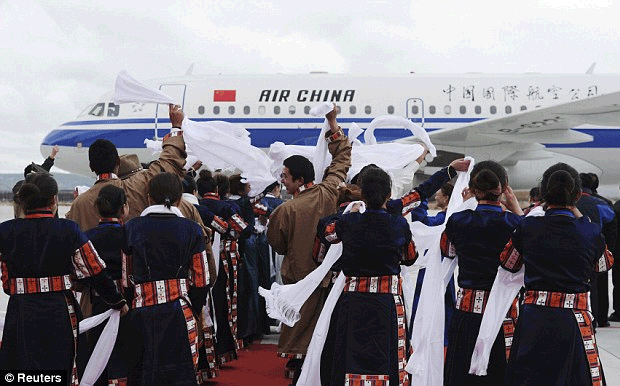|
The take-off from the newly-opened Daocheng Yading
Airport should be a relatively short affair.
Standing at 4,411 metres above sea level it is already half the height
of a plane's average cruising altitude.
|
|
 |
|
Perched in the mountainous Tibetan region of south-west Sichuan
Province, China's newest hub has broken the record for highest civilian
airport in the world.
It takes the title from Qamdo Bamda Airport, also in Tibet, which sits
at 4,334 metres.
The first Air China flight arrived at the 1.58 billion yuan
(£164million) airport on Monday to great fanfare and locals were seen
taking photos of themselves on the runway. |
|

|
|
The airport was built to connect the Garzi Tibetan Autonomous Prefecture
with the capital of Sichuan Province, Chengdu.
Travel between the two used to take two days by bus, but has now been
reduced to a one-hour flight.
Designed to handle 280,000 passengers a year, China hopes the airport
will encourage tourism to the Yading Nature Reserve, a mountainous area
that is a site for Tibetan pilgrimage.
Three of the snowy peaks - Mount Yangmaiyong, Mount Xiaruoduijie, and
Mount Xianairi - were sanctified by the 5th Dalai Lama and the area is
known for being barely touched by outside influence. |
|

|
|
The Chinese government hopes to attract 15 million tourists to the
Tibetan regions by 2015, which would bring two billion yuan
(£205million) into the country.
However, both the tourism plan and airport are controversial, as they
help to further Chinese political control in Tibet.
The number of self-immolation incidents carried out by monks and
protestors over Chinese rule has risen in the past two years, leading
China to close the border to foreign visitors on several occasions.
|
|
 |
|
Tibet declared its independence from China in 1913, but the Chinese army
re-entered the country in 1950, bringing it back under Chinese power.
|
|
 |
|
The Tibetan head of the Buddhist religion, the Dalai Lama, fled to India
in 1959 and has since led calls from Tibet to regain its independence
and for the protection of the Tibetan culture from Chinese influence.
|